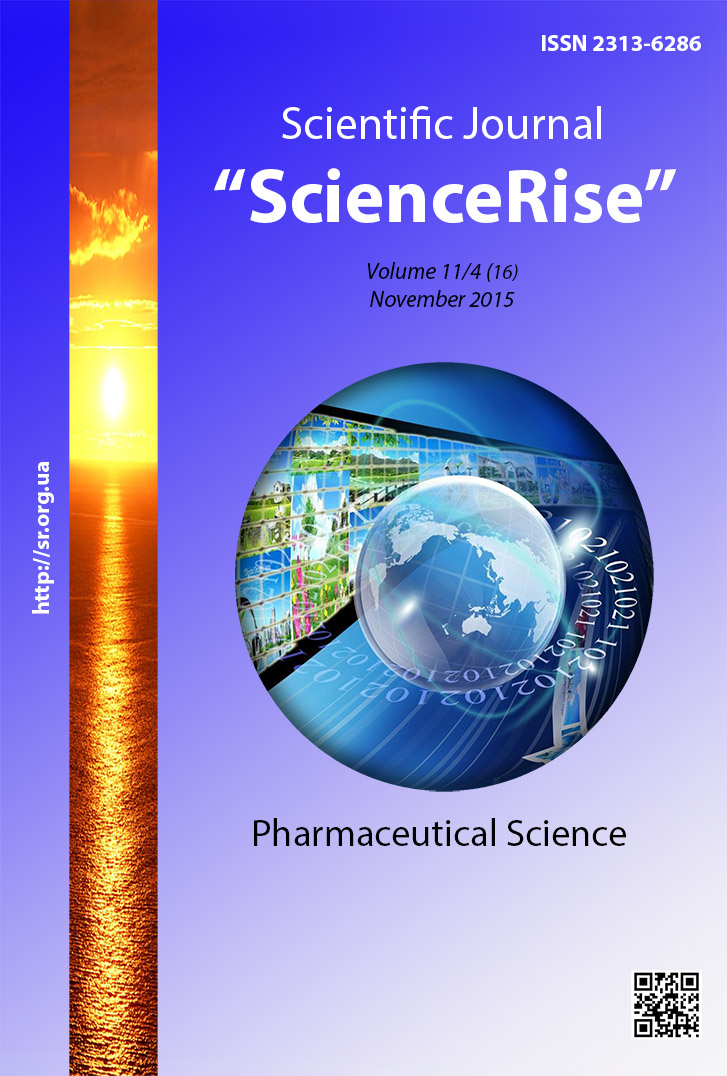Perspectives of using greater plantain in the medical and pharmaceutical practice
DOI:
https://doi.org/10.15587/2313-8416.2015.54487Keywords:
greater plantain Plantago major, pharmaceutical market, chemical composition, phytotherapy, herbal medicinal productsAbstract
Expansion of the use range of well-known plant objects in medicine and pharmacy is a pressing task in the pharmaceutical science. Modern science has discovered pharmaceutical characteristics of many plants, however nowadays we still have a large volume for research in the field of phytotherapy. Greater plantain Plantago major is one of the well-known medicinal plants, which remains interesting for studying and creating medicinal products based on it.
Goal. The goal of our work was to study literature sources regarding biochemical composition of medicinal plant – greater plantain and a range of herbal medicinal products based on it represented on the pharmaceutical market of Ukraine.
Methods. Literary search for information regarding Plantago major, as well as structural, comparative and graphical analysis methods of the pharmaceutical market of Ukraine were made to solve the set goal.
Results. As a result of the work literary data analysis was conducted in regard to the chemical composition of Plantago major and study of domestic pharmaceutical market relating to herbal medicinal products which were composed of greater plantain and other species of Plantago L.
Summary. Medicinal plant Plantago major is of value and is a prospect for future studies, as well as development and creation of new original medicinal products based on it
References
Zhienbaev, T. M., Kurmanova, F. E., Omarova, R. A., Bevz, N. E. (2013). Maslyaniye extracty romashki aptechnoy (Matricaria chamomilla) [Oil extracts of chamomile (Matricaria chamomilla)]. Medicines for people. Modern problems of pharmaceutical therapy and appointment of medicines. Kharkov, 191–196.
Borodina, T. N., Rumsh, L. D., Ckunizhev, S. M. Sukhorukov, G. B. et. al (2007). Vkluchenie extractov lekarsvennyh rasteniy v biodegradiruemyie microcapsuly [Including of extracts of medicinal plants in biodegradable microcapsules]. Biomedical chemistry, 53 (6), 662–671.
Kuznetsova, L. S., Glushko, A. A. (2013). Technologicheskyie issledovaniya atravmaticheskogo ranevogo pokrytiya s sokom podorozhnika I analiz adsorbtsii biologicheski aktivnyh veschestv soka na kollagene [Technological researches of non-traumatic wound covering with plantain juice and analyze of adsorption of biological active substances of juice on collagen]. Modern problems of science and education, 6, 1026.
Nickolaeva, Yu. N. (2011). Krapiva, lopukh, podorozhnik, zveroboy. Lekarstva ot 100 bolezney [Nettle, burdock, plantain, St. John's wort. Medicines for 100 illnesses]. Moscow: RIPOL classic, 110.
Badalyan, Z. V. (2011). Summarnye fitopreparaty podorozhnika bolshogo – vozmozhnosty sovershenstvovaniya tekhnologii [Total herbal medicines of plantain – possibility of improving technology]. Scientific sheets, Series Medicine, Pharmacy, 22 (117), 125–130.
Sosnina, S. A., Oleshko, G. I., Pecherslaya, L. G. et. al (2008). Vidy podorozhnika: soderzhaniye deistvuyuschikh veschestv [Types of plantain: content of active substances]. Pharmacy, 8, 21–24.
Olennikov, D. N., Samuelsen, A. B., Tankhaeva, L. M. (2007). Podorozhnik bolshoy (Plantago major L.). Khimicheskiy sostav i primeneniye [Plantain (Plantago major L.). Chemical composition and application]. Chemistry of herbal raw materials, 2, 37–50.
Olennikov, D. N., Tankhaeva, L. M. (2006). Razrabotka technologii polucheniya extracta podorozhnika bolshogo sukhogo [Development of technology obtaining plantain dry extract]. Chemistry of herbal raw materials, 1, 47–52.
Olennikov, D. N., Tankhaeva, L. M., T. M. Mykhailova, Samuelsen, A. B. (2005). Organicheskie kisloty lekarstvennykh rasteniy Plantago major L. [Organic acids of medicinal plants Plantago major L.]. Chemistry of herbal raw materials, 4, 354–355.
Tamura, Y., Nishibe, S. (2002). Changes in the Concentrations of Bioactive Compounds in Plantain Leaves. Journal of Agricultural and Food Chemistry, 50 (9), 2514–2518. doi: 10.1021/jf011490x
Kortikov, V. N. (2001). Polnaya entsiklopedia lekarstvennykh rasteniy [Full encyclopedia of medicinal plants]. Rostov-na-Donu, 511.
Amr, A. (2007). Merits of anti-cancer plants from the Arabian Gulf region. Cancer Therapy, 5, 55–66.
Kobeasy, I. M., Osama, M. (2011). Biochemical studies on Plantago major L. and Cyamopsis tetragonoloba L. International Journal of Biodiversity and Conservation, 3 (3), 83–91.
Samuelsen, A. B. (2000). The traditional uses, chemical constituents and biological activities of Plantago major L. A review. Journal of Ethnopharmacology, 71 (1-2), 1–21. doi: 10.1016/s0378-8741(00)00212-9
Ovodov, Yu. S. (2009). Sovremenniye predstavleniya o pectinovykh veschestvakh [Modern ideas about pectin substances]. Bioorganic chemistry, 35 (3), 293–310.
Yakovleva, L. V., Marchishin, S. M., Lenytska, O. B., Kozachok, S. S. (2013). Vivchennia antyalergichnoi dii novykh oryginalnikh roslynnykh zboriv [Studying of new original plant species with antiallergenic action]. Phytotherapy. Journal, 2, 37–41.
Olennikov, D. N., Tankhaeva, L. M., Nikolaeva, G. G. (2004). Metodica kolichestvennogo opredeleniya summarnogo soderzhaniya organicheskikh kislot v rastitelnom syrje [Technique of quantitation of total content of organic acids in herbal raw material]. Plant resources, 40, 112–117.
Khortetska, T. V. (2013). Doslidzhennya optymalnykh umov sushinnya listya podorozhnika serednogo [Research of optimal conditions of drying of leaves of plantain]. Zaporozhye medicinal journal, 2 (77), 101–103.
Downloads
Published
Issue
Section
License
Copyright (c) 2015 Ірина Вікторівна Герасимова

This work is licensed under a Creative Commons Attribution 4.0 International License.
Our journal abides by the Creative Commons CC BY copyright rights and permissions for open access journals.
Authors, who are published in this journal, agree to the following conditions:
1. The authors reserve the right to authorship of the work and pass the first publication right of this work to the journal under the terms of a Creative Commons CC BY, which allows others to freely distribute the published research with the obligatory reference to the authors of the original work and the first publication of the work in this journal.
2. The authors have the right to conclude separate supplement agreements that relate to non-exclusive work distribution in the form in which it has been published by the journal (for example, to upload the work to the online storage of the journal or publish it as part of a monograph), provided that the reference to the first publication of the work in this journal is included.

